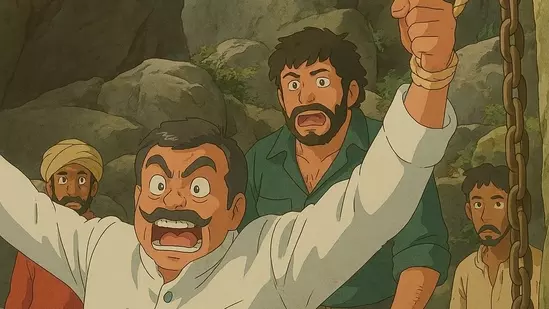Ghibli or Gibberish?
A new OpenAI update lets users generate Studio Ghibli-style art in seconds, leaving illustrators fuming, besides raising questions about principles

The AI-powered ‘Ghiblification’ has kindled heated discourse
If you’ve scrolled through X in the last hours, you’d be forgiven for thinking you’d stumbled into films from Japanese animation major Studio Ghibli. Picture-perfect scenes in the signature aesthetic of famed animator, manga artist and director Hayao Miyazaki; lush greenery with a touch of whimsy; have taken over timelines. But here’s the catch: None of these was painstakingly hand-drawn over months by human illustrators. They were spit out by OpenAI’s latest image-generation update in mere seconds, proving once again that Artificial Intelligence is here to amuse and horrify us in equal measure.
AI-Ghibli fad
The AI-powered ‘Ghiblification’ has kindled heated discourse. On one hand, casual users are giddy over seeing themselves, their pets, and even Bollywood blockbusters like Dilwale Dulhania Le Jayenge and Bhool Bhulaiyaa reimagined in Ghibli-esque style. On the other hand, actual artists are less than thrilled by an algorithm imitating a lifetime of skill, patience and of course talent.
AI-Ghibli fad
The AI-powered ‘Ghiblification’ has kindled heated discourse. On one hand, casual users are giddy over seeing themselves, their pets, and even Bollywood blockbusters like Dilwale Dulhania Le Jayenge and Bhool Bhulaiyaa reimagined in Ghibli-esque style. On the other hand, actual artists are less than thrilled by an algorithm imitating a lifetime of skill, patience and of course talent.
While some argue that AI art tools merely expand creative possibilities rather than erase human artistry, others see it as a boot pressing down on the neck of independent illustrators, who now have to compete with an algorithm that doesn’t need sleep, pay, or validation.
Studio Ghibli itself is having none of it. The animation house has fired off a cease-and-desist letter to ChatGPT’s flagship chatbot using the studio’s name and style without permission. It has demanded that the same stop using Ghibli’s name, characters, and artistic essence, citing copyright violations and consumer confusion.
‘Utterly disgusted’
But it’s not just about legal implications, it’s also about principles. A 2016 clip of Ghibli’s co-founder Miyazaki has resurfaced on the net, in which he reacts to a demonstration of AI-generated animation with withering disgust: “I would never wish to incorporate this technology into my work at all. I strongly feel this is an insult to life itself.”
Cost of convenience
Fast forward to 2025, and it seems Miyazaki’s worst fears are playing out in real-time. With a few clicks, anyone can now create a ‘Ghiblified’ version of Oppenheimer, Sholay, or even Lionel Messi’s last match.
Mehdi Saajid, a new media artist who dabbles in AI, views Artificial Intelligence as just another tool in the creative arsenal. But he draws a firm line when it comes to copyright infringement. “If someone directly uses Ghibli’s name, visual language, or markets something as ‘Ghibli-style,’ that’s misuse. Ghibli has every right to protect it.”
Saajid, who originally envisioned his Ninjabee project, a Hijabi superhero story from Hyderabad, as a live-action film, eventually made it a graphic novel using AI in its early stages. “It wasn’t about skipping effort but making something palpable under real constraints,” he explains. His stance highlights a crucial distinction: AI as an aid to creativity versus AI as an unchecked, soulless imitator.
Degrades effort
Others, like London-based film critic Shaurya Thapa, acknowledges that AI is here to stay, but urges people not to forget the sheer time and effort required to create traditional hand-drawn animation. He cites The Glassworker by Pakistani animator Usman Riaz as an example of Ghibli’s influence channelled the right way — through meticulously crafted human effort, not shortcuts.
Even outside the animation world, the battle over AI’s role in creative industries is heating up. In 2024, over 10,000 artists, musicians and writers, including Kazuo Ishiguro, Julianne Moore, and Radiohead’s Thom Yorke, signed an open letter condemning the unlicensed use of creative works to train AI models like ChatGPT.
Ethical dilemma
And yet, the temptation of instant creativity is hard to resist. Take Suraj L, a software engineer from Ahmedabad who used the AI tool to transform his own photos into Studio Ghibli-style frames. “I found a lot of joy in making those images,” he shares. But, when technology makes creativity effortless, does it also make it meaningless? What unsettles him is seeing AI-generated Ghibli-style art used to create “cute renditions of hateful messaging or events.” This, he says, makes him ask how such misuse of AI-generated art can be curbed. Mehdi asks, “Are we letting machines dictate aesthetics, or are we using them to expand our creative vocabulary?” The answer, he suggests, lies in awareness, authorship and responsibility. But if Miyazaki’s grim outlook is correct, we might already be living in the epilogue of an AI-generated dystopian fable.
Ethical dilemma
And yet, the temptation of instant creativity is hard to resist. Take Suraj L, a software engineer from Ahmedabad who used the AI tool to transform his own photos into Studio Ghibli-style frames. “I found a lot of joy in making those images,” he shares. But, when technology makes creativity effortless, does it also make it meaningless? What unsettles him is seeing AI-generated Ghibli-style art used to create “cute renditions of hateful messaging or events.” This, he says, makes him ask how such misuse of AI-generated art can be curbed. Mehdi asks, “Are we letting machines dictate aesthetics, or are we using them to expand our creative vocabulary?” The answer, he suggests, lies in awareness, authorship and responsibility. But if Miyazaki’s grim outlook is correct, we might already be living in the epilogue of an AI-generated dystopian fable.
( Source : Deccan Chronicle )
Next Story

